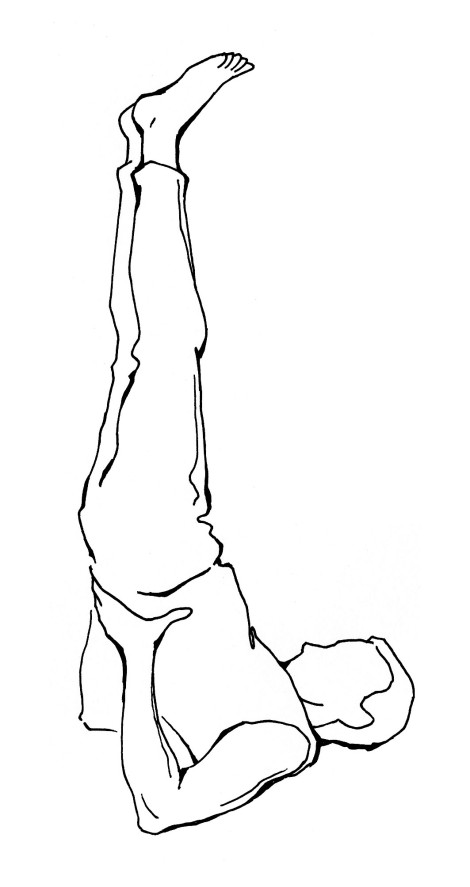Sarvangasana (inverted shoulder stand)
Sarvangasana is the second of the twelve basic poses of Hatha Yoga. It is an inverted pose and sometimes called the ‘Queen of Asanas’. In Sanskrit, sarva means whole and anga means parts of the body; as the name suggests, this asana is an excellent tonic for the whole body.
It is highly beneficial to include an inverted pose in one’s yoga practice. Inverted asanas improve the blood circulation to the brain and help remove stale blood from the lower limbs. They also benefit the digestive system and many other organs of the body.
Though sirshasana (the head stand) is probably better known, sarvangasana offers all the benefits, minus the possible harms of sirshasana.
Procedure:
- Lie on your back on the mat with legs stretched out, palms near the body – this is the starting position.
- Relax the body for a few moments.
- Bend the knees and fold your legs, with the heels near the buttocks.
- Inhale and raise your legs off the ground by using the contraction of the abdominal muscles. Do not jerk and slowly raise your legs, taking about ten seconds to get the legs perpendicular to the ground – at this stage, the buttocks should be on the ground.
- Raise the buttocks and legs slowly and keep your legs together.
- Lift the trunk, hips, and legs vertically. Support the back with the two hands, one on either side of the waist.
- Rest the elbows firmly on the ground.
- Make the body vertical to the ground; the body should be supported on your shoulders.
- In the final posture, the chest should rest on the chin, exerting a gentle pressure on it (this is the jalandhara bandha).
- Breathe normally in this final position – initially, it may be difficult to maintain it for more than a few seconds. With practice, it is quite beneficial to stay in this posture for two to three minutes.
From this position, you can either – a. go on to do halasana b. get back to the starting position.
Getting back to the starting position: Take extra care that you don’t jerk or fling your way back to the starting position.
- From the perpendicular state, bend the legs so that they are over and behind the head and parallel to the ground.
- Very slowly, release the position of the hands to let the body rest on the mat.
- Rotate the legs slowly so that they come to rest on the ground. Try not to use the hands while doing this; without hands, the abdominal muscles will be nice massaged.
Notes:
- This asana calls for graceful movement of the body, while lifting the legs and while returning back to the floor. Please make sure that there are no jerks in your movement.
- The head should remain firmly on the mat during the whole practice.
- Try to ensure that the chest presses the chin – this will result in the jalandahara bandha, a highly beneficial practice. The main reason why some are unable to do so is because the trunk is not raised high enough. Use your hands to make your trunk perpendicular to the ground. Remember – the chest should press against the chin and not vice versa.
- Do not force or strain to touch the chin. Those with stiff necks will find this difficult initially; but they will be able to do so with practice and patience.
Breathing: Retain breath inside or outside while raising and lowering the body. Breathe normally in the final position.
Awareness: On the smooth movement of the body while moving in or out of the final posture. In the final position, on the breath process, especially at the throat.
Precautions: People suffering from slipped discs, cerebral thrombosis and severe neck injuries are advised not to practice this asana. Those with excessive high blood pressure, weak hearts, glaucoma or other eye disorders should not practice it. Though sarvangasana has a wonderful impact on the thyroid, those suffering from an excessively enlarged thyroid should not practice this asana, till the swelling is reduced.
It should not be done during menstruation or advanced stages of pregnancy.
Stop the practice if you experience any of these:
- Dizziness
- Excessive perspiration
- Palpitations of the heart
- And if you feel very uneasy
Benefits:
This asana is a panacea and provides immense benefits to the practitioner.
It influences the thyroid gland directly and thereby improves the metabolism of the body. It brings about hormonal balance and helps to normalize the body weight by balancing the endocrinal system.
It calms the brain and helps relieve stress and minor cases of depression.
Sarvangasana improves supply of blood to the brain, thus rejuvenating it.
It improves flexibility of the spine and particularly tones those nerves that pass through the neck.
Because of the pressure of the chest on the chin, it allows for deep abdominal breathing.
Sarvangasana is very useful for asthmatics since it promotes abdominal breathing.
It is used to alleviate piles, menstrual problems, sexual problems as well as constipation.
It relieves pressure from the veins of the lower body (varicose veins).
Those with mild cases of high blood pressure will benefit from it greatly, though people suffering from excessively high blood pressure are advised not to practice this asana.
Since the whole neck and face regions are flooded with blood during this asana, it improves facial complexion and reduces wrinkles.
Above all, it is a very calming asana and brings about tranquility of the mind. It is an excellent asana to do before meditation.

Leave a comment